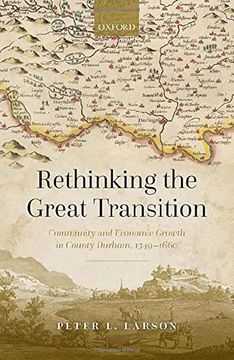Share
Rethinking the Great Transition: Community and Economic Growth in County Durham, 1349-1660 (Hardback) (in English)
Peter L. Larson
(Author)
·
Oxford University Press, USA
· Hardcover
Rethinking the Great Transition: Community and Economic Growth in County Durham, 1349-1660 (Hardback) (in English) - Larson, Peter L.
$ 105.00
$ 142.50
You save: $ 37.50
Choose the list to add your product or create one New List
✓ Product added successfully to the Wishlist.
Go to My WishlistsIt will be shipped from our warehouse between
Friday, May 17 and
Monday, May 20.
You will receive it anywhere in United States between 1 and 3 business days after shipment.
Synopsis "Rethinking the Great Transition: Community and Economic Growth in County Durham, 1349-1660 (Hardback) (in English)"
This case study of two rural parishes in County Durham, England, provides an alternate view on the economic development involved in the transition from medieval to modern, partly explaining England's rise to global economic dominance in the seventeenth century. Coal mining did not come tothese parishes until the nineteenth century; these are an example of agrarian expansion. Low population, favourable seigniorial administration, and a commercialised society saw the emergence of large farms on the bishopric of Durham soon after the Black Death; these secure copyhold and leaseholdtenures were among the earliest known in England. Individualism developed within a strong parish and village community that encouraged growth while enforcing conformity: tenants had freedom to farm as they wished, within limits. Along with low rents, this allowed for a swift expansion ofagricultural production in the sixteenth century as population rose and then as the coal trade expanded rapidly. The prosperity of these men is reflected in their lands, livestock, and consumer goods. Yet not all shared in this prosperity, as the poor and landless increased in number simply bypopulation growth. Through reformation and rebellion, these and other parishes prospered without experiencing severe disruption or destruction. In north-eastern England, agrarian development was an evolution and not a revolution. This study shows England's economic development as a single narrative, woven together from a collection of regional experiences at different times and at different speeds.

